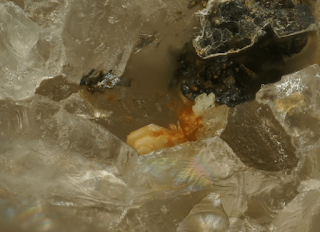Ichnusaite is an incredibly rare and captivating mineral that belongs to the actinide molybdate family. Considered among the world's rarest and most valuable minerals, it surpasses even diamonds in rarity due to its limited availability. The mineral holds particular significance for Italy as it was first discovered on Italian soil, specifically at the breathtaking Su Seinargiu site in Sarroch, Sardinia, in 2013.
The Unique Properties of Ichnusaite
Ichnusaite's chemical formula is Th(MoO4)2-3H2O. The crystals of Ichnusaite are colorless and thin, exhibiting a tabular shape, and can reach lengths of up to 200 microns. Often, these crystals are found in conjunction with other minerals like muscovite, xenotime-(Y), and nuragheite. The mineral's luster is strikingly pearl-adamantine, giving it a unique and captivating charm.
One of the intriguing properties of Ichnusaite is its brittleness and perfect cleavage characteristic. Due to the scarcity of the material, some vital information like its density and optical properties are still unknown. However, the mineral's thin layers are held together by hydrogen bonds, providing its structure with a unique stability.
The Origin of the Name, Ichnusaite
The name "Ichnusaite" is an homage to the ancient Greek roots of the island of Sardinia. The island was referred to as "Ichnussa" by the ancient Greeks due to its distinctive footprint-like shape.
The Significance and Utility of Ichnusaite
Ichnusaite offers valuable insights into the crystallochemistry of actinide molybdates. It's believed that these minerals might form during the alteration process of spent nuclear fuel. This discovery holds immense importance as it could potentially play a pivotal role in controlling and releasing radionuclides in nuclear storage conditions.
Furthermore, the scientific significance of Ichnusaite lies in its uniqueness and its association with actinide molybdates. This opens new avenues for research to better comprehend the formation and behavior of these minerals in nuclear settings. The discovery of Ichnusaite marks a milestone in the domains of mineralogy and materials chemistry, enhancing our understanding of the intricate interactions between spent nuclear fuel and its environment.
Ichnusaite: A Delicate and Rare Sardinian Mineral
In 2016, Jesse Ausebel, along with researchers from the Carnegie Institution of Washington and the Deep Carbon Observatory, published a remarkable list of over 2,500 world's rarest minerals in the Journal of American Mineralogist. Ichnusaite topped this list, earning the title of the world's rarest mineral. However, the fragile nature of these minerals often leads to their disappearance, making them unsuitable for trade, as they can vanish with mere contact with water or sunlight.
Ichnusaite, an invaluable geological gem, derives its worth from its extraordinary rarity. The total amount of this captivating mineral is so minute that it could fit within a simple thimble, making it a unique marvel in the world.
While these rare minerals are not available for sale, their real value lies in the insights they provide about the conditions and elements beneath the Earth's surface that led to their creation. They offer crucial information about our planet's history and geological changes. As the authors of the study published in the Journal of American Mineralogist highlight, these rare minerals truly differentiate Earth from all other planets.
Among the minerals in Sardinia was found Nuragheite
Nuragheite is the second thorium-molybdenum mineral found at Su Seinargiu, Sarroch, Sardinia. It turns out to be an exceptional actinide molybdate. Its brute formula, Th(MoO4)2-H2O, testifies to the uniqueness of its composition. Its crystals, like those of Ichnusaite, occur in a tabular form, which is colorless and thin, reaching an impressive length of about 200 microns. In fascinating synergy with muscovite, xenotime-(Y) and ichnusaite, nuragheite offers a spectacle of rare beauty and scientific importance. Its luster exhibits pearl-adamantine hues like its "twin" Ichnusaite.
This mineral is vulnerable in its delicacy, also showing perfect cleavage. Despite its rarity, its close association with Ichnusaite limits the available information regarding density and optical properties. However, the successive crystalline sheets are masterfully joined through hydrogen bonds, revealing even more of nature's majesty.
Nuragheite and ichnusaite share fascinating structural features, offering new insights into the crystallochemistry of actinide molybdates. These minerals, with the ability to form during the alteration of spent nuclear fuel, as mentioned earlier, could prove crucial in influencing the release of radionuclides under storage conditions. This discovery sheds light on an unknown world of possibilities, pushing the boundaries of our scientific understanding and opening new avenues toward a safer and more sustainable future in radioactive materials management.
The world's most valuable and rare minerals
The word "rare" has been used in a variety of mineralogical contexts. For the authors of the previously mentioned study, "rare" means minerals that have been recorded in five or fewer localities, a condition that applies to at least 2,550 species, or more than half of all minerals approved by the International Mineralogical Association (IMA). Many of these minerals have a total known volume of less than 1 cm3. This definition thus differs from the more colloquial use of the term "rare mineral," which is often associated with precious stones.
However, diamonds, rubies, emeralds, and other precious gems are found in numerous locations and sold in commercial quantities, and thus are not considered rare in the sense used in this context. The use of the word "rare" in reference to "rare earth elements" or "rare metals" is equally misleading, since thousands of tons of these commodities are produced annually. Note that alternative definitions of rarity could be proposed, such as based on the total volume of the Earth's crust or the mass of each mineral.
The world's rarest and most valuable minerals include:
- balyakinite Cu2+Te4+O3
- carlfriesite CaTe6+Te24+O8
- mroseite CaTe4+O2(CO3)
- clearcreekite Hg1+3(CO3)(OH)-2H2O
- hanawaltite Hg61+Hg2+O3Cl2
- donharrisite Ni8Hg3S9
- birchite Cd2Cu2(PO4)2SO4-5H2O
- drobecite CdSO4-4H2O
- lazaridisite (CdSO4)3-8H2O
- swedenborgite NaBe4Sb5+O7
- alburnite Ag8GeTe 2S4
- ichnusaite Th(MoO4)2-3H2O
- alsakharovite-Zn NaSrKZn(Ti,Nb)4(Si4O12)2(O,OH)4-7H2O
- carbokentbrooksite-(Na,o)12(Na,Ce)3Ca6Mn3Zr3NbSi25O73(OH)3(CO3)-H2O
- johnsenite-(Ce) [Na12Ce3Ca6Mn3Zr3WSi25O73(CO3)(OH)2
- senaite Pb(Mn,Y,U)(Fe,Zn)2(Ti,Fe,Cr,V)18(O,OH)38
Cover image credits: Philippe Roth


Post a Comment